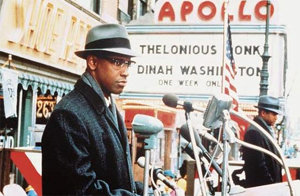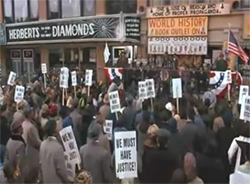PRODUCTION DESIGN // "MALCOLM X" (1992) |
Designing MALCOLM X
|  |
|
Could you discuss the logistics of shooting at locations versus recreating them somewhere else? Wynn Thomas: Well, obviously 125th Street had to be recreated; part of the problem is you can't shoot on 125th Street [today], it's impossible. We needed something [where] we could control the flow of traffic, and be able to take a couple of buildings and restore them to the way they would have looked in the '40s and '50s. So I found a section of 3rd Avenue between 118th and 121st. It's a travelled street, but not as congested as some of the cross-town avenues — it was a street we could block off for several days and control the traffic. Also, the scale and the detail of the buildings were very similar to the buildings on 125th Street. There was a vacant building there that had these sort of arched windows that looked like a theatre, plus one of the significant landmarks from that time period was a store called Herbert's Diamonds, and there was the African Bookstore which was right next to Herbert's. So those two things had to be on our block — there are famous photographs of rallies where Malcolm is speaking in front of this particular bookstore.
The thing that was good about the Apollo was that you could tell what time period it was by looking at the artists that were on the marquee. So that was a very good time indicator for us. And on the other side of the street, I had to create the entrance to Small's Paradise. I was trying to consolidate so the company would not have to make a move. Small's doesn't exist anymore? No, Small's Paradise was on 7th Avenue and 135th Street. The building still exists but its insides have all been torn out. What other landmarks had to be re-created? Well, Temple Number 7 and the Moslem luncheonette were constructed up in Harlem. We essentially took over a building and gutted it, and built on the second floor Temple Number 7, completely — we actually had to knock out a retaining wall in order to get the size that was necessary for that meeting room. And then right below it, was the luncheonette (which is where it would have been realistically). So I essentially took over an existing building, completely gutted it and treated every single surface — put in floors, put in ceilings, put in walls, everything was resurfaced. That was done on 116th Street between 7th and 8th Avenues. How about the early scenes set in Boston? In fact we originally were supposed to go to Boston, but the opening shot is in Brooklyn. We completely covered every single storefront that was there — we again came in and rebuilt the set on top of existing buildings. The barbershop was a very large storefront and I essentially closed it and built a set within this very large space. But Boston was a major job. We had to really resurface every single building that was there. In the movie you see Woolworth's there's like a market — underneath all those facades are existing stores that had nothing to do with what we were trying to do. So it wasn't simply taking a Woolworth's and making it into a period Woolworth's? Oh, no, no. I think it was a clothing store or something behind the Wooldworth's facade. But again we need certain specific detail and none of those stores were correct. The reason I chose that street was because it had the elevated line, and Dudley Station at that period was an elevated station. It doesn't exist anymore — they've torn it down — so the idea was to duplicate the elevated subway system, and below the elevated subway were all these commercial stores, so that's the reason I chose that particular location. I know Lee had wanted to shoot at the Audubon Ballroom, where Malcolm X was assassinated, and in fact the exterior was used — you can tell when we are shown a wounded Malcolm being rushed across the street to Columbia Presbyterian Hospital. We couldn't use the interior for a variety of reasons. Spike was very adamant in shooting at the Audubon, and we investigated and scouted it, but basically the inside is in very poor shape; the roof was shot, it had been raining on the inside, the floors were buckled, and it doesn't look the way it would have looked during Malcolm's assassination. So it would have required completely going in and redoing the whole thing. And our initial estimates in order to do that were $750,000, just to do cosmetic treatment. Which was more than what it cost Spike to shoot his entire first movie! Well, yes, but we couldn't afford that. We tried to find cheaper ways of doing it, [such as] not using the whole space, cutting it in half. That reduced our [projected] cost, so we were planning on shooting it there. But what happened was, while my guys were beginning to work there it turns out there was a big asbestos problem in the ceiling. And as a result of that we had to stop work. So we were delayed for several weeks while waiting to get the asbestos situation taken care of. They cleaned out the asbestos problem, we got the certificate to work there, but at that time period the bond company had come in and they essentially told us that we couldn't afford to do it. [The film was running over budget and Lee had to deal with the film's completion bond company to maintain control while finishing the picture.] So we went back to the Hotel Diplomat on 43rd Street, which we had used as the Roseland Ballroom. We used that same space to do the Audubon. I essentially had 4 to 5 days to totally alter it and I put in a stage, completely painted it and covered up a lot of the details to disguise it. So we shot two major scenes at this one hotel. What was the most difficult aspect of dressing a period picture? The big difficult sets for us were all the commercial streets. All of that stuff goes by very quickly on film, but it takes a lot of layers to get the details correct so that people aren't jarred by it. I'm sure most people think that we shot it on 125th Street. When you resurface every single building, it's time consuming, and expensive. Both those streets (125h Street and the Boston set) were about $750,000 in terms of budget. Since you were recreating a time period — in particular a period with which many in the audience are familiar with — do you have much artistic leeway to design sets, or are you limited to historically correct choices? I think obviously the answer to that is the first hour (during Malcolm's years as a criminal) were a lot more colorful and liberating in terms of designing the film. That was the one section where I could use my imagination, as opposed to trying in Part 3 the Temple Number 7 and the luncheonette; all that is based on concrete research. Whereas in Part 1, it's really just what I felt it should be, is how it was really designed. It wasn't based on any research or anything factual. Not even the Roseland Ballroom? Uh-uhm. It's just how I saw it. Where were the prison sequences shot? The prison was the Essex County Prison in Newark NJ, which was a prison that was built during or shortly after the Civil War. It's been closed for several decades, and we got permission from the city of Newark to shoot there. We had to essentially go in and repair the place because it was a complete mess, but it had a similar feeling of the Charleston Prison where Malcolm was. [The Charlestown Prison was also built in 1860-something, so it had a very similar feeling.] In all, how much pre-production time did you have? I had six months. Was that enough? No! No, it wasn't. I think we could have used another two months — we were very rushed. We were shooting a different set every day, so there were over a hundred locations. And sometimes the same setting but redressed in a different period. Did your shooting schedule force you to shoot periods out of order? No, the movie was shot in sequence, and the primary reason was because of Denzel's hair! You know he had to get his hair conked for the first section, it remains conked for a little bit in the prison, and then he cuts it, then we had to give his hair a week to grow. All those scenes where he's wearing hats, one of the reasons [for that] was to disguise the fact that his hair was too short. But we had to shoot the movie in sequence because of the hair issue. The fact that he got to act out that character's development in chronological order must have benefited his performance. I'm sure it had an impact on his performance, but it had a bigger impact on the schedule. That whole schedule was designed around his hair.  Postscript: Thomas' recent credits as designer have included CROOKLYN, TO WONG FOO, THANKS FOR EVERYTHING, JULIE NEWMAR, MARS ATTACKS, ANALYZE THIS (and THAT), A BEAUTIFUL MIND, INSIDE MAN and GET SMART. |
copyright 1992, 1997, 2009 by David Morgan
All rights reserved.







 So we ended up using two blocks and restoring them to the way they would have looked in the '40s and '50s, adding Herbert's Diamonds, adding the African bookstore, and then putting the Apollo Theater on there. Now technically the Apollo was nowhere near the bookstore or Herbert's Diamonds — the Apollo would have been down the street — but because I had to condense things for the film, I actually put them all on the same side of the street. So it's kind of like major landmarks from that particular time period were designed onto a set.
So we ended up using two blocks and restoring them to the way they would have looked in the '40s and '50s, adding Herbert's Diamonds, adding the African bookstore, and then putting the Apollo Theater on there. Now technically the Apollo was nowhere near the bookstore or Herbert's Diamonds — the Apollo would have been down the street — but because I had to condense things for the film, I actually put them all on the same side of the street. So it's kind of like major landmarks from that particular time period were designed onto a set.